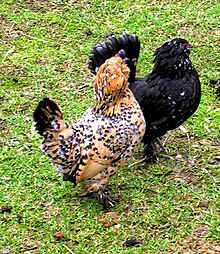Bearded d'Uccle

Belgian d'Uccle Bantams in the Millie Fleur and Black Mottled colors
|
|
| Other names |
|
|---|---|
| Country of origin | Belgium |
| Standard |
Bantam Club Français Poultry Club of Great Britain |
| Traits | |
| Weight |
|
| Classification | |
| APA | feather legged, with Muff and Beard |
| ABA |
single combed, muff and beard and feather legged, Type: body broad and deep. Back very broad, almost hidden by enormous neck hackle. Breast extremely broad, the upper part very developed and carried forward, the lower part resembling a breastplate. Tail well furnished, close and carried almost perpendicularly to the line of the back. Legs strong, short and well apart,... |
|
|
single combed, muff and beard and feather legged, Type: body broad and deep. Back very broad, almost hidden by enormous neck hackle. Breast extremely broad, the upper part very developed and carried
The Barbu d'Uccle or Belgian d'Uccle,Dutch: Ukkelse Baardkriel, is a Belgian breed of bearded bantam chicken. It was first bred in the town of Uccle on the outskirts of Brussels, Belgium.
The Barbu d'Uccle was created by Michael Van Gelder of Uccle, Belgium, in the early years of the twentieth century. It is thought, but not known for certain, that he cross-bred the existing Sabelpoot and Barbu d'Anvers bantam breeds. The Barbu d'Uccle was first shown in 1905.
In 1911, the American artist and poultry enthusiast Arthur O. Schilling saw the mille fleur variety of the breed during a trip to Europe, and imported several to the United States. Schilling, who photographed and illustrated many breeds for the Standard of Perfection of the American Poultry Association , was visiting C. S. Th. van Gink, another poultry artist of the era. The mille fleur variety of the Barbu d'Uccle was recognised by the APA in 1914.
The Barbu d'Uccle has a low posture, full beard and a muff, a short but well developed neck, body broad and deep. Back very broad, almost hidden by enormous neck hackle. Breast extremely broad, the upper part very developed and carried forward, the lower part resembling a breastplate. Tail well furnished, close and carried almost perpendicularly to the line of the back. Legs strong, short and well apart. It has a single comb, unlike the Barbu d'Anvers, which has a rose comb.
The American standard specifies an ideal weight of 26 oz (740 g) for cocks, 22 oz (620 g) for hens and cockerels, and 20 oz (570 g) for pullets. The Poultry Club of Great Britain suggests as a rough guide a maximum weight of 790–910 g for males and 680–790 g for females, with variations taking into account age and maturity.
...
Wikipedia
